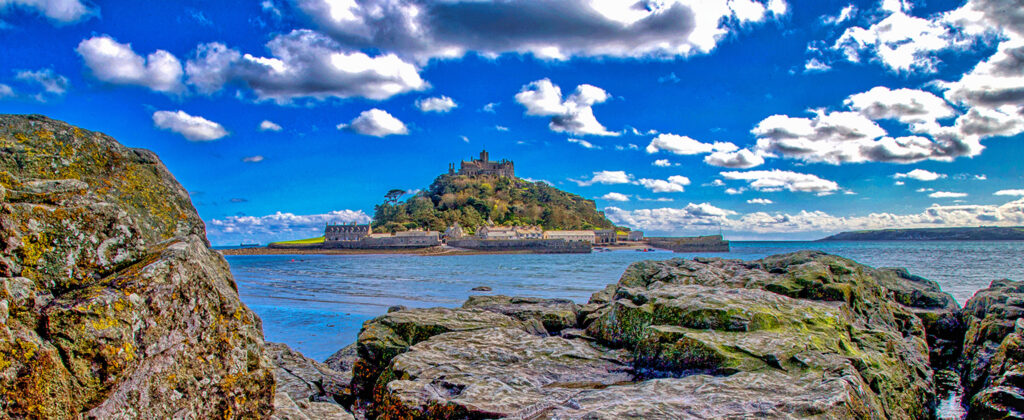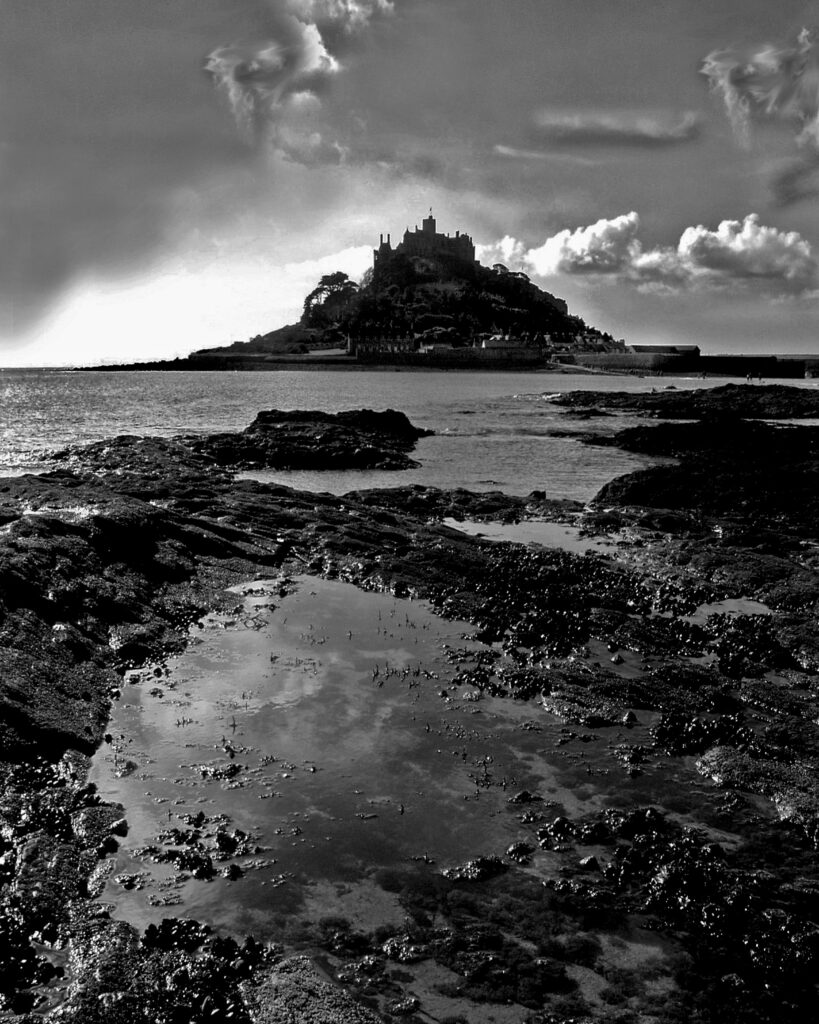Most castles in Cornwall were built as fortresses centuries ago, their stout granite walls surviving many a battle. Over the years the weather may have beaten the walls down to almost ruins, but with a little imagination and a history book, we can see them again as they once were.
One castle which needs no imagination because it has been kept in excellent condition and is lived in, is St. Michael’s Mount set in the middle of Mount’s Bay, near Penzance. Few visitors to West Cornwall can fail to see this fairy-like castle built on the top of an island 250 feet above sea level, as they drive along the A30 to Penzance or travel by train to the last station in Cornwall, as the railway line runs along the shore of Marazion (the town nearest the Mount) and just gazing at the whole island as it towers above you – an awe inspiring sight. There is a mystic fascination in staring at the little harbour with its piers like two arms embracing the boats within its shelter, and then looking upwards over the roofs of the cottages nestling round the harbour, over the tops of the trees which grow up the rocky slope to the granite castle at the top. When the tide is low, you can walk from Marazion beach to the Mount in a few minutes across a cobbled causeway – laid by the giant Carreg-Cowse, more of him later! I’ve had great fun racing the tide on its inward journey, and many is the time I have had to take off my sandals and paddle the last few yards.
Few castles in England, let alone Cornwall, have given more to history than St. Michael’s Mount. Steeped with religion, and stirred by the battle cries of soldiers, it has “see-sawed” between the church and the crown for most of its life. Before anything was built on it, the island was named “Dinsol” which is a name half Celtic and half Latin meaning “hill of the sun”. This is very appropriate as you can always sit in the sun on the island at any time of day if you follow its journey from east to west.

The old Cornish name for it was Carrek Los y’n Cos, which means the grey rock in the wood. This makes one wonder if the woodlands of the now sunken city of Lyonesse really stretched across Mount’s Bay and St. Michael’s Mount was once a huge rock in the middle of a forest. Most historians say the island called Ictis from which records show tin was shipped, was St. Michael’s Mount. Tin certainly was shipped from it. In 200 B.C. the Greeks were acquainted with Cornwall and records show that tin was shipped from this island to France probably Brittany, a journey which took thirty days! In the Bronze Age, Irish traders came to St. Michael’s Mount via Hayle River, to trade their copper and gold. Ships from Marseilles carried on a traffic in tin from here too. Tin is mentioned in the Bible as being one of the riches of Tyre “it being brought from the Westward”, and Joseph of Arimathea was among the traders. Fact and fantasy, church, and crown, all mingle together to make the most fascinating reading in the history of the Mount.
Edward the Confessor founded the Priory of Benedictine monks on the Mount and Robert Earl of Moreton made it a cell of the Abbey on Mont St. Michel in Normandy. A prior and twelve monks were sent from Normandy to St. Michael’s Mount by the Norman Abbot, and the Priory was consecrated in 1135. These Benedictine monks were excellent gardeners and brought plants and trees from Normandy including narcissi bulbs – as did their brothers on Tresco, Isles of Scilly. The Mount must have looked very beautiful then, probably full of colour and the southern slopes carpeted with lilies. One can imagine the tranquillity of the place, with the monks going about their business of prayers and gardening. In those days Normandy was an appendage of the English crown, and the Abbots there were appointed by the English King. The Prior appointed to the Mount was obliged to pay 16 marks a year to the Norman Abbot.
The original church dedicated by Bishop Warelwast in 1135, is stated to have been destroyed by an earthquake in 1275, although there is no record of this in the Episcopal Register. Maybe the forest said to be covering the floor of Mount’s Bay disappeared too at that time.
The present church was built during the 14th century and although very small, seems to hold such an array of interesting items that on reflection it seems barely possible that centuries of history could be crammed into so small a building. The Rood Screen built by Sir John Arundell in 1433 was removed in the 18th century during repairs. After further repairs in 1811 the beautiful Rose Window was installed. The radiant brightness of this window must be seen to be believed. The two tall eastern windows are unusually designed, and in the central panel of the Reredos the head of John the Baptist can be seen. Near the altar, a stone stairway leads to an underground chamber about nine feet square. It is thought to be a cell used for the correction of refractory monks, as a similar one existed at Mont St. Michel in Normandy.
The tower contains six bells, five of which are 14th century. This church tower also served as a lighthouse, as Sir John Arundell provided the money for an octagonal lantern to be fixed in the tower to provide light to guide fishermen into the tiny island harbour. You can sit in this stone lantern if you like, as it stands in the south-west angle of the tower parapet, but if you are married you must use your own discretion, as the first married partner to sit in it, will be the boss!
The most interesting room in the castle is the Chevy Chase Room. It contains a very lovely frieze which shows scenes of hunting for beasts and birds, and dates from the reign of Charles II. His arms also hang over the fireplace. Also in this room are the arms of St. Aubyn and Godolphin. John St. Aubyn, who died in 1684, married Catherin, daughter of Francis Godolphin of Trevaneage and the present occupier of St. Michael’s Mount (Lord St. Levan) is a direct descendant. The very large drawing room contains valuable paintings and portraits of the family, by the Cornish artist Opie.
If you join the thousands of visitors to the Mount during the summer months, the guide will tell you that the giant who lived on the island made the causeway which links with the mainland at low tide, to enable him to play bowls with the giant of Trencrom (the highest hill of West Cornwall). One of their “woods” still lies today in a little stream at the foot of Trencrom Hill and is known as Bowl Rock, and is now preserved by The National Trust.
When the giant of the Mount died, his heart was cut out and is buried under the pathway which leads up to the castle. In fact, the guide will show you the exact spot, and if you put your foot on the stone covering the heart you can feel it still beating – providing you also put your left hand on your left breast!

You will agree it is a rare sight to see the Archangel St. Michael. He was seen by the Italians on Mount Garganus, and by the French on Mont St. Michel. The fishermen of Cornwall also saw him sitting on a rock at St. Michael’s Mount in 495 A.D., and he became the guardian of all seafaring men. The rock on which he appeared is known as St. Michael’s Chair and is on a craggy tor on the west side of the island.
As you leave the castle by the west entrance with the St. Aubyn alms over the door, stand for a minute (despite the gale of wind) and try to imagine the siege in 1473 when the Earl of Oxford held the Mount with only 80 men against the King’s Army of 6,000. Notice the rusty cannon just below you, which is all the physical help your imagination will get nowadays to make you realise how vulnerable the Mount was.
Look down to the rocks below and imagine the hand-ful of monks hurrying to their boat when they were expelled from the Mount by John brother of Richard I, in 1189. Henry de la Pomeray occupied the Mount on behalf of John, but in 1206 King John gave it back to the Prior, and the monks returned.
Occupation of the Mount was never very stable. At least once during a century it would bounce from the crown to the church. The 16th century dealt the final blow to the church, for in 1536 under an Act of Parliament came the Dissolution of the Monasteries. In 1539, Henry VIII made Humphrey Arundell the first Governor of the Mount, and in 1599 when all the land, tithes, dues, etc., including the church were confiscated and taken by the crown, it was sold to Robert Earl of Salisbury.

William Earl of Salisbury sold it in 1640 to Francis Basset of Tehidy, near Camborne, and the next few years saw the Mount filled with soldiers. The Royalists held it in 1642 during the Civil War. In 1647 Col. John St. Aubyn was nominated Captain of the Mount and was the last of the Governors to maintain a garrison there. The Bassets of Tehidy sold the Mount to John St. Aubyn in 1659 and it has remained in the St. Aubyn family up to the present time. It is now the property of the National Trust and occupied by Lord and Lady St. Levan.
If you walk round the tiny harbour, pay a visit to the Marine Museum. Some very surprising exhibits are on view. Notice the Mount “railway” tucked away between the cottages. This carries almost everything except people up the steep tunnel to the castle. The 15th century pier, entry to which ships originally paid 1/- per year, was rebuilt in 1727 and enlarged in 1824, so the present harbour bears little resemblance to the first one. Maybe the tide has come in while you have been on your journey to the castle, so you will have to return to the mainland by ferry, which is a rowing boat expertly steered over the seaweed strewn rocks. Glance back as you leave that “Mystic Mount” and see how symmetrical it all is. How perfectly the castle blends with nature, and although rocks jut out here and there to the summit, the outline is perfect right up to the top of the flag flying from the church tower; the flag which was granted by Charles II in those far off days of the 17th century, when the Mount itself was then very old indeed.
